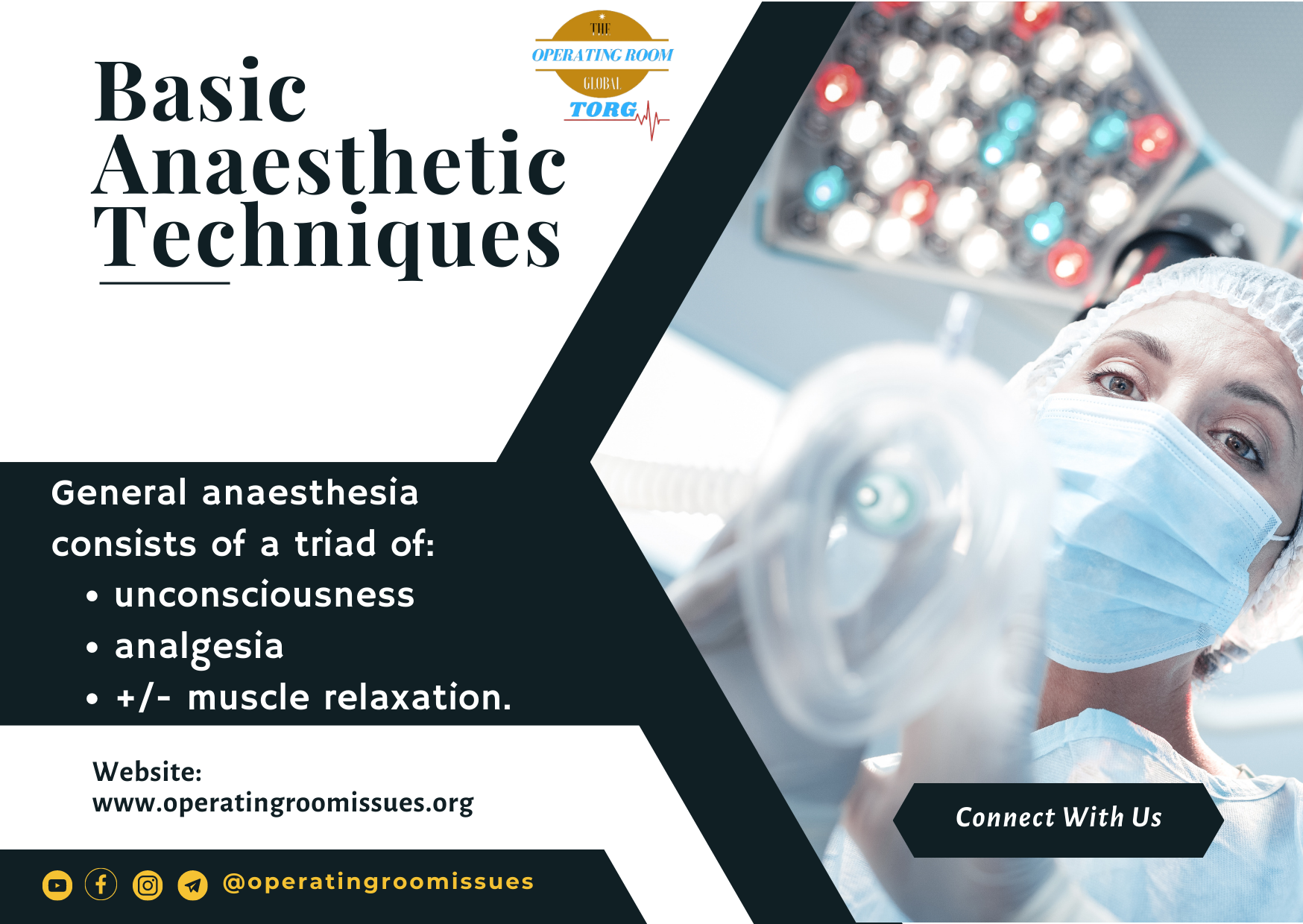General anaesthesia (GA)
As a novice trainee, general anaesthesia is the most common type of anaesthetic that you will be required to provide and become competent with.
General anaesthesia consists of a triad of:
- unconsciousness
- analgesia
- +/- muscle relaxation.
A general anaesthetic (GA) can be subdivided into 3 key stages:
- induction – getting the patient to sleep
- maintenance – keeping the patient asleep during the operation
- emergence – waking the patient up at the end of the procedure.
The most common techniques you will be exposed to are:
- spontaneous ventilation with a laryngeal mask airway (GA LMA SV)
- intermittent positive pressure ventilation with an endotracheal tube (GA ETT IPPV)
- Rapid Sequence Induction to protect the airway if there is a risk of soiling from gastric contents (RSI GA ETT IPPV).
Your choice of technique will be influenced by specific patient, surgical and anaesthetic factors, as well as the level of your experience in the specialty and its related subspecialties.
The sections that follow will give you a broad overview and the basic principles underpinning these three techniques.
General anaesthesia: spontaneous ventilation with an LMA
Generally used for elective or emergency surgery in patients who have been fasted and where there is no risk of aspiration of gastric contents. Common risk factors for aspiration include:
- history or reflux or hiatus hernia
- intra-abdominal pathology
- pregnancy
- recent major trauma or administration of opiates
- morbid obesity
- autonomic dysfunction associated with diabetes.
Suitable for most peripheral surgery in patients who are not obese and for some minor abdominal surgery where muscle relaxation is not needed (i.e. elective inguinal hernia repair).
Can be used for patients in the supine or lateral position. Not recommended for use in very long cases.
Experienced anaesthetists may use this technique in ENT and Maxillofacial surgery for short procedures.
Basic principles in ASA 1/2 patient:
- attach basic monitoring (SpO2, ECG and NIBP)
- pre-oxygenate the patient
- induction – intravenous (propofol) or inhalational induction (sevoflurane) + small dose of fentanyl followed by insertion of LMA
- maintenance – oxygen/air or oxygen/nitrous oxide plus volatile or intravenous agent
- emergence – 100% Oxygen and turn off volatile or intravenous agent. Remove LMA when patient wakes up.
General anaesthesia: endotracheal intubation and positive pressure ventilation
Generally used for elective or emergency surgery in patients who have been fasted and where there is no risk of aspiration of gastric contents but where:
- muscle relaxation is required to facilitate surgery
- surgery will increase intra-abdominal pressure or the bowel will be manipulated
- surgery could take a long time
- airway is shared with the surgeon and may lead to airway soiling with blood or debris
- prone patients or those where positioning require their head to be at the opposite end of the table.
Basic principles in ASA 1/2 patient:
- attach basic monitoring (SpO2, ECG and NIBP)
- Pre-oxygenate the patient
- induction
- intravenous (propofol) or inhalational induction (sevoflurane) + small dose of fentanyl
- non-depolarizing muscle relaxant to facilitate intubation
- manual ventilation until relaxant effective
- oral or nasal endotracheal intubation and confirmation of tube placement by visualization, auscultation and capnography
- maintenance
- oxygen/air or oxygen/nitrous oxide plus volatile agent
- top up doses of muscle relaxant guided by neuromuscular monitoring
- additional analgesia as required
- emergence
- 100% oxygen
- turn off volatile or intravenous agent
- reverse neuromuscular block
- remove ETT when patient spontaneously breathing and wakes up.
General anaesthesia: Rapid Sequence Induction
Used for elective or emergency surgery in patients who are either not fasted or where there is a risk of aspiration of gastric contents. The airway is protected from aspiration by the application of cricoid pressure prior to rapid intubation using a depolarizing muscle relaxant. Thereafter, the anaesthetic technique is the same as an ETT with IPPV in the previous section.
Basic principles in ASA 1/2 patient:
- attach basic monitoring (SpO2, ECG and NIBP)
- pre-oxygenate the patient for 3 minutes
- proper preparation – tipping trolley, suction available, equipment checked
- induction
- intravenous (thiopental or propofol)
- suxamethonium to facilitate intubation with cricoid pressure applied by anaesthetic assistant to prevent aspiration
- oral intubation and confirmation of tube placement by visualization, auscultation and capnography
- release of cricoid pressure
- non-depolarizing muscle relaxant to maintain muscle relaxation
- maintenance
- oxygen/air or oxygen/nitrous oxide plus volatile agent
- top up doses of muscle relaxant guided by neuromuscular monitoring
- additional analgesia as required
- emergence
- 100% oxygen
- turn off volatile or intravenous agent
- reverse neuromuscular block
- remove ETT when patient spontaneously breathing, regains airway reflexes and wakes up
- it is recommended that this is performed with the patient in the left lateral position.
Other types of anaesthesia
Local infiltration
Good choice for skin and soft-tissue surgery of limited size, depth and duration, e.g. ring block for a distal finger operation.
Regional anaesthesia
Achieved by introducing a local anaesthetic agent near the nerves supplying that region. May be used as the sole mode of anaesthesia or combined with general anaesthesia or sedation.
Central (neuraxial) techniques for lower half of the body:
- spinal – hip or knee surgery
- epidural – below knee amputation
Plexus techniques:
- interscalene – shoulder surgery
- supraclavicular – elbow surgery
Single nerve techniques:
- femoral and sciatic – knee replacement surgery
- popliteal – ankle surgery
Intravenous regional anaesthesia:
- biers block – wrist fractures.

